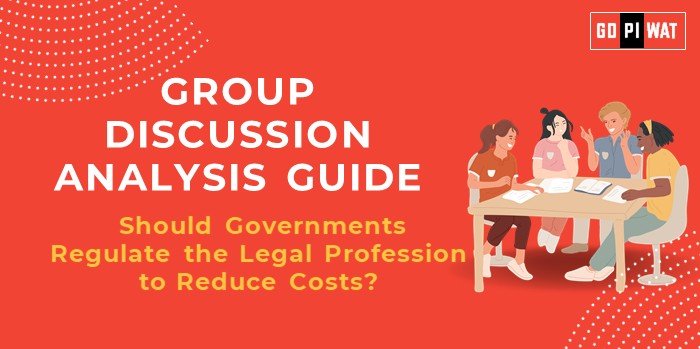body>
📋 Group Discussion (GD) Analysis Guide: Should Governments Regulate the Legal Profession to Reduce Costs?
🌐 Introduction to the Topic
- 💬 Opening Context: “The rising cost of legal services globally has raised questions about accessibility and fairness, sparking debates on whether government regulation could alleviate these challenges.”
- 📜 Topic Background: Governments often regulate sectors like healthcare and utilities to enhance public access. However, regulating the legal profession involves balancing autonomy, market efficiency, and public good.
📊 Quick Facts and Key Statistics
- 💸 Global Legal Expenses: Average cost of hiring a lawyer in the US: $250–$400 per hour, often unaffordable for middle-income families.
- ⚖️ Access to Justice: According to the World Justice Project (2023), over 60% of people globally lack access to affordable legal support.
- 🌍 Government Interventions: Countries like the UK have introduced fixed-fee systems for certain legal services.
- 📜 Legal Aid Gaps: In India, only 0.5% of cases in lower courts receive legal aid.
🔍 Stakeholders and Their Roles
- 🏛️ Government Agencies: Develop regulatory frameworks and provide subsidies for legal aid.
- ⚖️ Bar Associations: Set professional standards and oversee ethical practices.
- 🏢 Private Law Firms: Offer services and shape market trends through pricing strategies.
- 👥 Citizens: Demand affordable and quality legal representation.
🏆 Achievements and Challenges
Achievements:
- ✔️ UK’s Fixed-Fee System: Reduced ambiguity in legal costs for family law cases.
- 🤝 Legal Aid in Australia: Increased access for economically weaker sections.
- 💻 E-Courts in India: Decreased time and cost associated with case filing.
Challenges:
- 🚫 Market Resistance: Lawyers often oppose fee caps as they may reduce income potential.
- ⚠️ Service Quality Risks: Over-regulation might lead to lower service quality.
- 🌍 Global Comparisons: Canada provides extensive legal aid but struggles with backlogs.
- 📚 Case Study: India’s e-courts initiative improved access but exposed digital literacy gaps.
🎯 Structured Arguments for Discussion
- ✅ Supporting Stance: “Government regulation of the legal profession ensures fairness and broadens access to justice for marginalized communities.”
- ⚖️ Opposing Stance: “Regulation could stifle competition, leading to inefficiency and a decline in service quality.”
- 🤝 Balanced Perspective: “While regulation can control costs, complementing it with digital tools and legal literacy programs can ensure holistic reform.”
🗣️ Effective Discussion Approaches
- 📜 Opening Approaches:
- Use global statistics to highlight cost disparities.
- Reference successful regulatory models (e.g., UK fixed-fee system).
- Start with a provocative question: “Is justice a luxury only for the wealthy?”
- 🔄 Counter-Argument Handling:
- “While regulation may reduce costs, competition can ensure better quality.”
- “Subsidized legal aid programs address affordability without stifling market dynamics.”
🔍 Strategic Analysis of Strengths and Weaknesses
- 💪 Strengths: Enhances access, reduces inequality, promotes public confidence.
- 🔧 Weaknesses: Potential for overregulation, resistance from legal professionals.
- 🌟 Opportunities: Technology integration, public-private partnerships.
- ⚠️ Threats: Implementation barriers, risk of inefficiency.
💼 Connecting with B-School Applications
Real-World Applications: Link to corporate governance projects, compliance roles.
Sample Interview Questions:
- 💡 “Should cost regulation extend to other professional services?”
- 💡 “How can AI aid in legal affordability?”
Insights for Students:
- Explore the intersection of law, policy, and technology.
- Develop strategies for balancing regulation with market efficiency.


